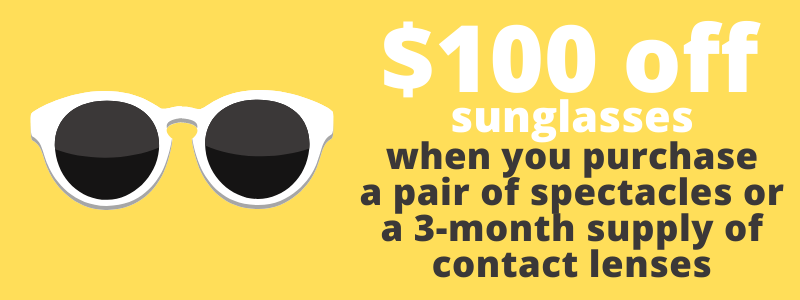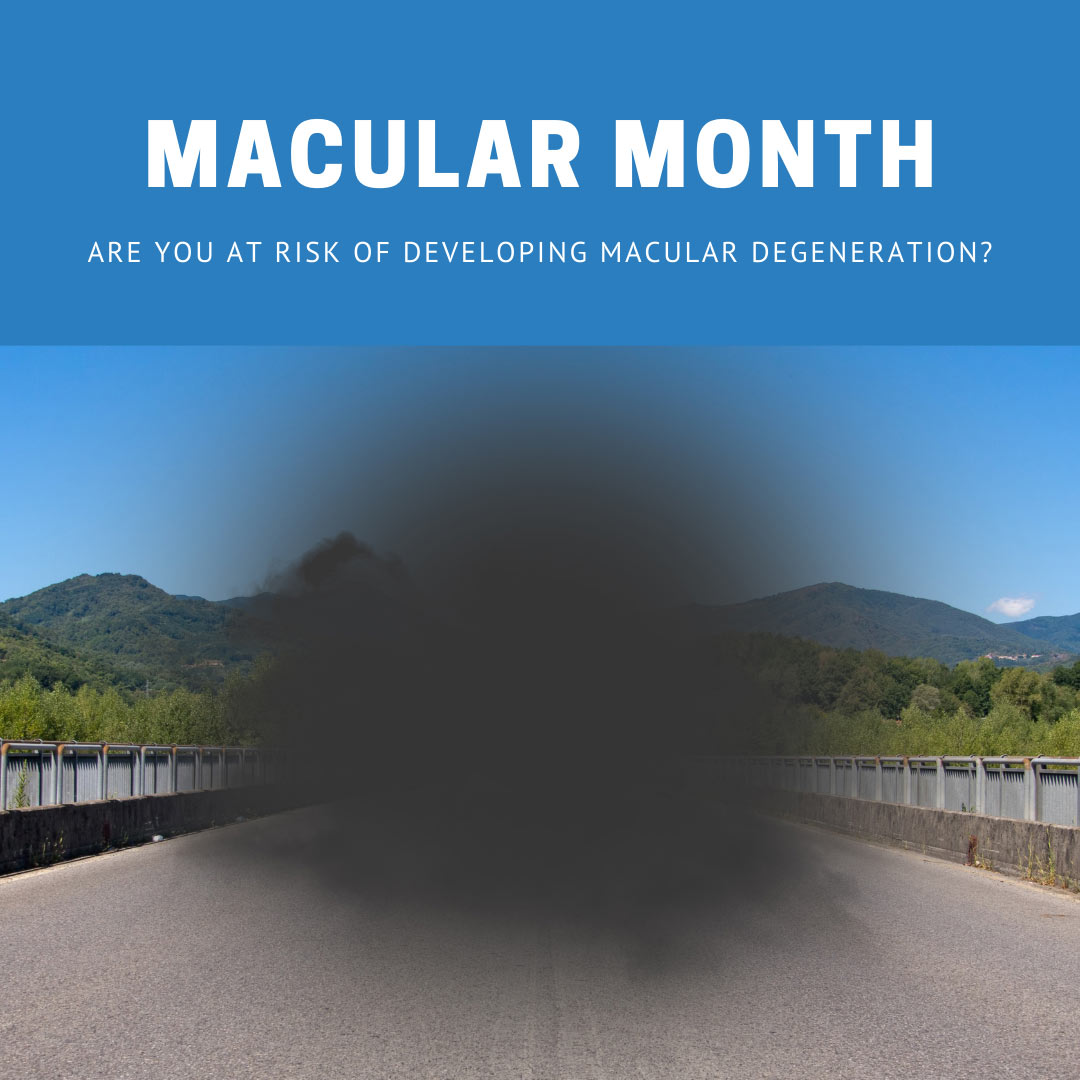Holiday Trading Hours
Holiday Trading Hours
Friday, December 24: 9am - 1pm
Our practice will be closed from Saturday, December 25 and will re-open Tuesday, January 4.
On behalf of everyone at Bay Optics, we wish you all a happy and safe holiday season.
Have you used your health fund benefits?

2022 is fast approaching, which means most health fund rebates will expire unless you make a claim.
To get into the end of the year spirit and to help with a fresh new look, we'd like to gift you $50* towards your next pair of spectacles or sunglasses.
This offer is valid from 1 November until 31 January 2022, so even if you've used your optical health fund benefits for this year, you can make a new claim from 1 January and take advantage of these great offers.
Book in your consultation now.
*Redeemable for new purchases from 1 November 2021 towards purchase of complete frames and lenses. To claim your 2021 rebate, orders must be collected by 31 December 2021. Not to be used in conjunction with any other discounts, packages or offers. Not redeemable on contact lenses. One voucher per patient only.
What is blue light and do we need to protect our eyes from it?
Last year saw an influx of new buzzwords. COVID-19 ruled, of course, but it was in good company with ‘pivot’, ‘new normal’, ‘zoom’ and ‘social distance’. Equally buzz-worthy and a concept that may have hit your radar at a similar time are blue light filtering glasses. Since these are the only buzzworthy concepts from the aforementioned list that we can speak of with authority, let’s take a look into what exactly blue light is and why it’s causing such a stir.
What is blue light?
Blue light is part of the visible light spectrum – it’s the light we can physically see whereas ultraviolet (UV) and infrared light are outside the visible light spectrum. Light is made up of electromagnetic particles that travel in waves. These waves range in length and strength and emit energy. The length of these waves is measured in nanometres (nm) with 1 nanometre equalling 1 billionth of a metre.
Blue light comes from both natural and artificial sources. Sunlight is a natural source, while the blue light emitted from digital screens, electronic devices and LED lights is artificial. Blue light has a very short wavelength and as a result produces more energy. Studies suggest that long term exposure to blue light may damage your eyes.
How does blue light affect us?
Sunlight is the main source of blue light and is everywhere. Our bodies use blue light to regulate our natural sleep cycles, otherwise known as our circadian rhythm. Our mood, level of alertness and overall wellbeing can be aided by natural blue light.
Blue light waves are the shortest, highest energy wavelengths of the visible light spectrum, in turn meaning they can potentially damage the internal structures of the eyes such as the retina and macula. Children are particularly susceptible to these damaging effects since the young eye is less able to filter blue light.
Blue light and ARMD
Clinical studies suggest that exposure to High Energy Visible (HEV) blue light can be a risk factor for macular degeneration.
Age and lifestyle factors such as poor diet and smoking are even greater risk factors for the development of age-related macular degeneration (ARMD).
Digital eye strain
Blue light is believed to be responsible for digital eye strain. Flickering blue light from digital screens creates glare and impacts visual clarity, contrast and sharpness. Blue light has also been implicated in migraines.
Today, we have a plethora of electronic gadgets to keep us connected with friends, family and colleagues, not to mention entertain ourselves (Netflix anyone?). Unfortunately, one of the by-products of this use of technology, is the amount of time we are spending staring at digital screens, often excessive.
Sadly, it’s not just adults that are affected. Children are increasingly using digital devices to play, read and even do schoolwork. This combination of more screen time and less “green time” (time spent outdoors in nature and natural light) can harm children’s vision and puts them at risk of developing myopia or near-sightedness.
There are certain factors when it comes to reducing the risks for children developing myopia that are within parents’ control, the main one being keeping screen time to a minimum. The World Health Organization (WHO) released daily screen guidelines for young children in April 2019. They recommend infants (less than 1 year old) should not have any screen time while those aged 2-5 should have no more than 1 hour of screen time per day. The American Academy of Paediatrics goes on to suggest that children over the age of 5 and into teenage years, don’t need a specific time limit put in place so long as digital consumption doesn’t interfere with physical activity and sleep.
To help parents/ carers, we’ve put together our top 5 suggestions to help minimise screen time and reduce digital eye strain.
5 tips for parents dealing with increased screen time
- Choose wisely – make a point to check up on what your kids are watching or playing. Children don’t always know what’s appropriate for their age and it’s easy for them to lose track of time. There’s a host of apps available to help you monitor your child’s viewing habits so consider these if necessary.
- No screen time before bed and keep devices out of the bedrooms at night.
- Make time for media with your kids but don’t forget reading. Reading to your child promotes bonding and prepares them for learning.
- Practice what you preach. Kids are very good at observing those around them so be mindful of how much time you personally spend on devices. Make a point to schedule downtime and allocate time for chores, outdoor time, reading and homework.
- Consider blue light filtering lenses such as TechShield Blue (even if you’re not a prescription glasses wearer) as they assist in reducing the amount of blue light penetrating the eye.
How to protect your eyes against the sun
By embracing some simple actions and making them a way of life, you and your family can safely enjoy the great outdoors while protecting the health of your eyes and the sensitive skin around them.
- Wear sunglasses year-round whenever you are out in the sun. Sun damage to the eyes can occur any time of year.
- Wear sunglasses marked category 2, 3 or 4, which provide good UV protection.
- Category 0 or 1 novelty or toy sunglasses with coloured lenses don't provide enough protection and should be avoided.
- Polarised lenses are great for cutting out reflected glare and are useful for the beach, fishing and driving.
- Sunglasses are also available for those who need prescription lenses and come in tinted, polarized or photochromatic (darken with the sun) options.
- Wear a broad brimmed hat with tightly woven fabric (no holes) to protect your face and the top of your head. Hats can block as much as half of all UV rays from your eyes and eyelids.
- Use a broad spectrum, water resistant SPF30 (or higher) sunscreen. Put it on 20 minutes before you go outdoors and every two hours thereafter. Sunscreen should never be used to extend the time you spend in the sun.
- Be aware of clouds: the sun’s rays can pass through haze and clouds, so eye protection is important even when there is cloud cover.
- Take extra care near water, snow and sand: 80% or more of the sun’s rays reflect off these surfaces, causing them to hit your eyes and skin a second time.
We’re making it easier for you to keep your eyes protecting with our latest offer. Get $100 off sunglasses when you purchase a pair of spectacles or a 3-month supply of contact lenses.*

*Offer ends October 31st. Not available in conjunction with any other offer. Offer can be used for both prescription and non-prescription sunglasses.
Are your devices causing you digital eye strain?
Have you been noticing that your eyes are more irritated and tired than usual? You’re not alone. For most of us, digital devices have a strong and growing presence in our lives. Computers, tablets, smartphones and other electronic devices with visual displays can all cause tired eyes and digital eye strain, referred to as ‘computer vision syndrome’.
What is computer vision syndrome?
Computer vision syndrome is the name for a group of eye and vision symptoms that might be experienced as a result of viewing digital devices for an extended period of time.
These symptoms can include eye strain, red or tired eyes, irritation, blurred vision, double vision and headaches.
Why does screen time irritate the eyes?
For most of us, our eyes prefer to focus further than six metres away, so viewing a computer screen forces our eyes to work harder. While it’s normal for us to blink about 15 times a minute, studies have shown that we blink far less often while using digital devices resulting in dry, scratchy and red eyes.
Generally speaking, the type or font that we are viewing on a digital device can be small or unclear, and glare is emitted off the screen from the blue light. The frequency of blue light emitted from LED devices is also being researched for its long-term effects on the eye and potential impact on altering sleep cycles.
The combination of these unique characteristics, and our eyes having to work harder, can often lead to difficulty. The extent to which people experience visual symptoms often depends on the level of their visual abilities and the amount of time looking at a digital screen.
Extended periods of focusing on screens up close results in the muscles having to exert significant focusing effort to make these objects clear. As with any of the muscles in the body, they can fatigue and tire out if not given the opportunity to occasionally rest and relax. The muscles which control eye movements and focusing are typically relaxed when we look at objects in the distance.
What to do to combat computer vision syndrome
It can be hard to remember to rest our eyes, but we should all apply the 20-20-20 rule when spending time on devices. The 20-20-20 rule is shifting your focus to something other than your device every 20 minutes. Then what you focus on should be 20 feet (6 meters) away and you should look at it, for at least 20 seconds.
Let’s all remember to apply the 20-20-20 rule daily so our eyes can stay at their best for longer.
If you are still experiencing eye strain or irritation, it is best to consult your optometrist to discuss the best treatment options for you. Book an appointment easily online today.
The Impact of COVID-19 on Eye Health
COVID-19 infected persons may develop conjunctivitis, which is characterised by sore, red, watery eyes. The eye can be a transmission route forCOVID-19 if a contaminated hand touches or rubs the eye, so it’s of vital importance to wash your hands and avoid touching your face.
How does COVID-19 spread?
The COVID-19 virus is primarily spread via person-to-person contact, through the release of respiratory droplets when an infected person breaths, coughs, or sneezes. It can also be spread via indirect contact, for example if a person touches the same object as an infected person, and then touches their mouth, nose or eyes. COVID-19 is highly infectious and spreads easily from person to person.
People who are infected but do not show symptoms can also spread the virus to others. On average it takes 5–6 days from the time of infection for symptoms to show, however it can take up to 14 days.2 How easily a virus spreads from person to person can vary.1 The virus that causes COVID-19 appears to spread more efficiently than influenza but not as efficiently as measles, which is among the most contagious viruses known to affect people.
Can COVID 19 affect your eyes?
Yes. The World Health Organisation (WHO) has classified conjunctivitis as a less common symptom of COVID 19 infection.1 Conjunctivitis is an infection or inflammation of the conjunctiva, the clear tissue which covers the white part of the eyeball.
Cases of conjunctivitis vary from 4% to 31% among those with a confirmed case of COVID.4 Signs of conjunctivitis are typically red, sore, watery eyes. This can be accompanied by itchiness and light sensitivity.
Conjunctivitis is a common condition overall with many causes including bacteria, allergens and viruses, so your Optometrist is well trained to lookout for the signs of COVID related conjunctivitis.
Can COVID-19 be transmitted via the eyes?
Yes, although attaining COVID 19 infection through the eyes is much less common than through the nose or mouth. The eye is more likely to be infected secondary to the primary infection, i.,e a contaminated hand touches or rubs the eye.3 This is why good hand hygiene is so important.
Prevention
To prevent infection and slow the transmission of COVID-19, the following is recommended:
- Practice physical distancing by avoiding unnecessary travel, and staying away from large groups of people, especially those with cold like symptoms i.e. coughing or sneezing
- Wash your hands regularly with soap and water, or clean them with alcohol-based hand rub
- Wear a mask when possible
- Avoid touching your face
- Cover your mouth and nose when coughing or sneezing
- Stay home if you feel unwell
Take home messages
COVID-19 infected persons may develop conjunctivitis, which is characterised by sore, red, watery eyes. Your eye care professional will be on the lookout for any such presentation and take necessary steps to prevent the spread of the disease. The eye can be a transmission route for COVID-19 if a contaminated hand touches or rubs the eye, so it’s of vital importance to wash your hands and avoid touching your face.
References
1 World Health Organisation, “COVID-19 Clinical management: living guidance,” 2021.
2 Australian Government - Department of Health, "What you need to know about coronavirus (COVID-19)," 2021.
3 Pradhan S, Vaughan M, Zhang J, et al Sore eyes as the most significant ocular symptom experienced by people with COVID-19: a comparison between pre-COVID-19 and during COVID-19 states. BMJ Open Ophthalmology 2020;5:e000632. doi: 10.1136/bmjophth-2020-000632
4 Dawood AA. Transmission of SARS CoV-2 virus through the ocular mucosa worth taking precautions. 2021;22(1):56-57. doi:10.1016/j.vacune.2021.01.007
Why do my eyes hurt in the cold?
One very common and frustrating eye issue that increases in its prevalence over winter is dry eye. The colder temperature can cause your eyes to lose natural moisture, becoming dry and sore. Although this isn’t usually a serious condition, it can cause discomfort. Here are out top tips to ease the symptoms of dry eye and keep your eyes healthy this winter.
May is Macular Degeneration Awareness Month
inFOCUS this month... an annual awareness campaign to help Australians understand their risk of macular disease. May is Macular Degeneration Awareness Month.
Macular disease covers a range of painless conditions affecting the central retina, known as the macula, which sits at the back of the eye. This disease is unfortunately the leading cause of vision loss and blindness in Australia.
The macula is responsible for detailed central vision used for activities such as reading, driving and recognising faces. It’s also responsible for most of your colour vision and it is only early detection and intervention that will save your sight.
checkmymacula.com.au offers a quick quiz to assess your risk however the best course of action is to maintain regular eye checks and ensure you reach out to us if you notice any changes with your vision, especially when reading or driving.








